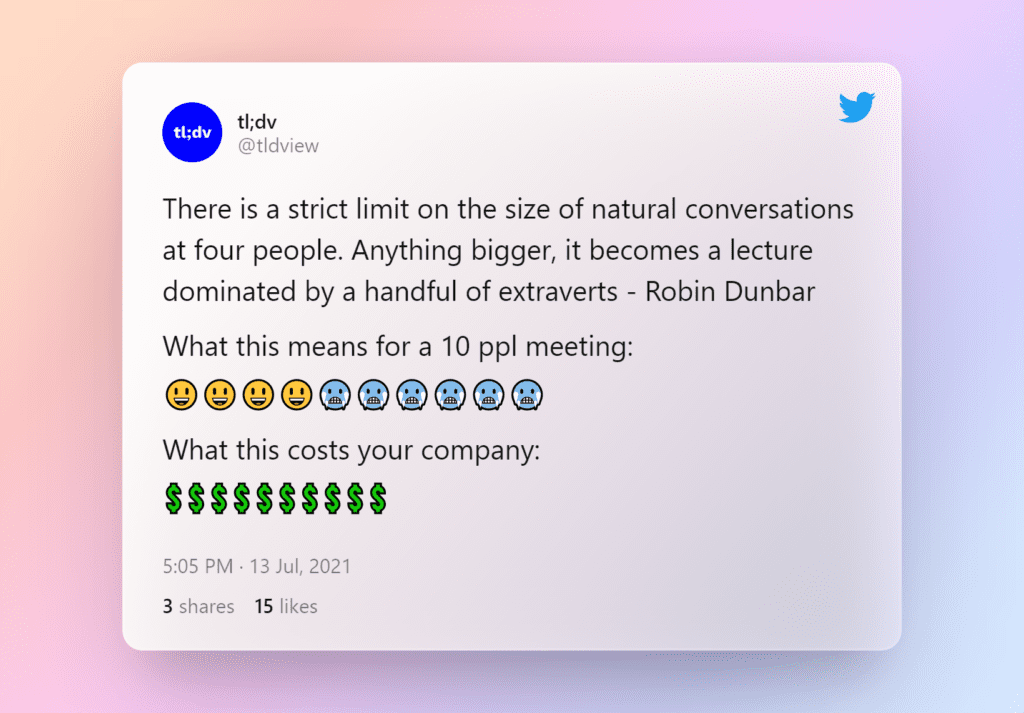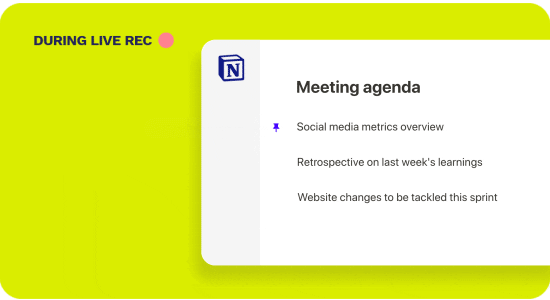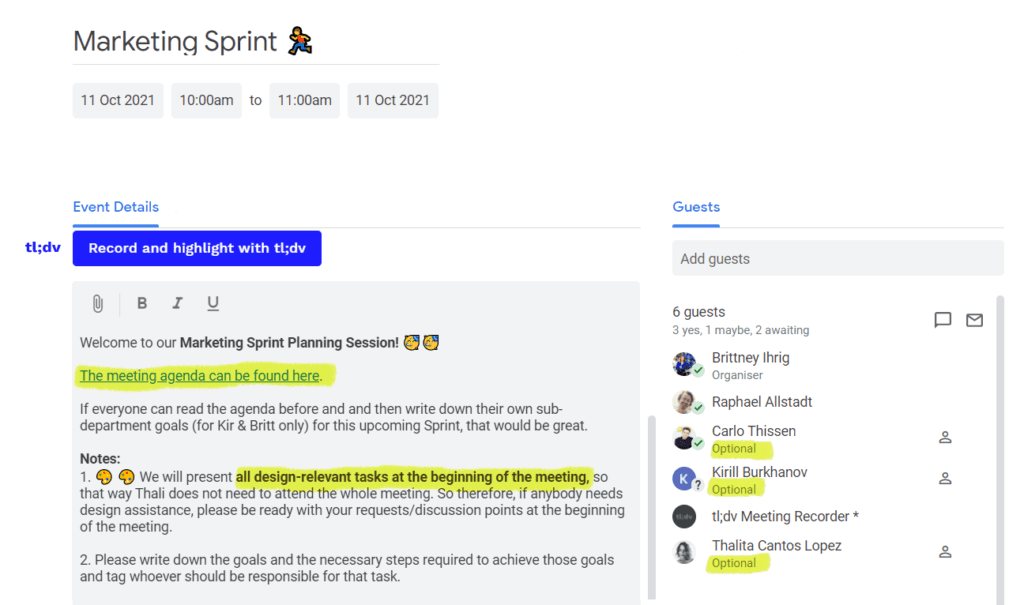The importance of Deep Work and the power of a team kumbaya is already well documented. We’ve covered this here, here, and here. Today, though, I’m discussing the alternative nuances of optional meetings. So let’s jump to it! (optional invitation, obviously 😆)@tldv.io Makes perfect sense. #meeting #comedy #corporate #meetings #9to5 #firstday ♬ original sound – tldv.io – AI Meeting Recorder
In this article
Optional meetings = better meetings
Meetings are no longer top-down or one-way exchanges of information. This is more so true of startups and async-first and remote teams. There are always, exceptions to the rule. Some meetings shouldn’t be skipped onboarding newly joined team members or important company-wide updates. However, in 99% of cases, optional attendance increases the quality of meetings.
Here are the main benefits we’ve observed over the 100s of voluntary meetings we’ve attended (and not attended) at tl;dv.
#1 Optional meetings motivate organizers
Forced attendance doesn’t do meeting organizers any justice: If all meeting “participants” are forced to attend, meeting organizers aren’t incentivized to improve the meeting experience. In an alternate meeting-world, if an organizer wants a higher attendance rate (which you cannot force), then they’re likely to make voluntary participation more enticing. This could look like:
- Selecting a convenient time for all.
- Thorough agenda planning, so all can evaluate the meeting’s value. Thus, attendees will arrive prepped, increasing the meeting's output.
- Items only relevant to fewer attendees may be addressed first.
- An open-mic session, so attendees can discuss relevant points.
💡TIP: Save your team’s time by not mandating 100% meeting attendance. Use that time saved for an optional bonding sesh!
Over time, this effect will be compounded. The organizer is incentivized to make optional meetings enticing the first time. The organizer also learns from what didn’t work. For example, let’s take a team bonding session. By seeing who DIDN’T attend, organizers can learn what their team enjoys, in order to make voluntary team bonding sessions better next time.
In short: optional meetings, like a good wine, get better with age. 🍷
#2 Optional meetings are leaner

Not everybody gets equal value out of any given meeting. Robin Dunbar says that conversations with more than 4 people become a lecture dominated by a few extraverts. Furthermore, forced meetings are often dominated by those with the most to gain.
For example, in a marketing sprint, the marketing manager is more likely to get the most value. The marketing-graphic designer will get limited value from topics unrelated to design. If the graphic designer is forced to attend the whole meeting, they’ll likely mostly silent and passive.
Making meetings optional eliminates the fear of exiting earlier and encourages only relevant people to attend. This benefits non-attendees (less time wasted, more deep-work time), and also attendees (more active participants = greater meeting output). With an average meeting cost of more than 1,000 USD per meeting, there is a lot of money to be saved too!
#3 Optional meetings are collaborative

As attendees are joining voluntarily, they have likely joined due to the meeting’s perceived value. This leads to increased investment in the meeting. Invested people are incentivized to work towards better outcomes.
So, rather than having 10 semi-invested meeting attendees, have 4 active and invested attendees. When you’re invested you’re more likely to focus on solutions, not problems, and only stick to the relevant information.
Equalize meeting power dynamics
The dynamics of non-optional meetings encourage a one-directional, inefficient, and passive meeting culture. Let’s look at a better way instead.
#1 Optional meetings = even playing field
Usually, meeting organizers are leads, managers, and executives. Hence, the organizer > invitee relationship is often inequal. This leads to less honest feedback and communication, impacting the output and value of the meeting.
Optional meeting attendance is one tiny step towards an equal power dynamic. The meeting organizer (usually the power-holder), is saying “hey, your time is just as important as mine”. With a balanced power dynamic, there is a greater chance for open feedback, therefore, more productive meetings.
#2 Optional meetings build trust
Optional meetings don’t guarantee team cohesion. But they are certainly an indication of trust. If you trust your employees to do their job, certainly they must be capable of allocating their time, and deciding which meetings need attending. Gone are the days meeting excuse Blackbooks.
If you trust your employees and have given them the environment to act autonomously, then optional meetings are a logical and natural next step.
How to do optional meetings well
So, in a perfect world, what does the holy grail of optional meetings look like?
Clear agenda

With a clear agenda and contextual background information, attendees will likely bring their pre-formed opinions and ideas to the table, ready to be discussed. More voices usually equates to better meeting outcomes. No meeting should ever be a big bag of surprises.
Make optional attendance explicit
We always make a conscious choice, at tl;dv to reinforce our meeting culture and ethos. After all, habits take time to form. Casually mentioning your company meeting policies once to new hires, is not sufficient. Here is how you could (or should) make this clear instead:
- Mark it on the meeting.
- Write it in the description.
- Reiterate this during the meeting.
- Reiterate your meeting culture and policies frequently with your team.
Reliable meeting documentation

This is the most important facet of optional meetings. Without proper documentation, then unfortunately the value of (optional) meetings will be lost for non-attendees. 😢 This will result in knowledge sinkholes in your company, creating information-asynchronicity, and reducing productivity.
In our team, we ensure robust meeting documentation by recording all relevant meetings (Sprints, user research sessions, hiring interviews, customer demos, onboardings, etc). During the meeting, we turn our meeting agenda into timestamped highlights (see above ☝️). Each timestamp transports you to the EXACT moment in your meeting recording. Don’t spend 60 minutes in a meeting for the 3 minutes you care about!
What does an optional meeting look like?

Here’s an example (above) of an optional Google Meet meeting. Note:
- Non-essential participants are indicated.
- Meeting agenda is clearly linked.
- Some points are raised first, allowing non-essential invitees to exit early.
- The meeting is tl;dv’ed.
Mandatory meetings =/= staying in the loop
With your proper meeting documentation ready, mandatory meetings are no longer the only way to keep your whole team in the loop! Now, any team member can be an async attendee to any QBR, Sprint, or online gathering.
Our favorite hack to squeeze value out of every meeting for “non-attendees” is to tag valuable and relevant meeting moments to the right person. This allows (for example) Jenny to be alerted directly on Slack when she’s tagged in a meeting moment. Click that timestamped messaged on Slack and it’ll take you DIRECTLY the exact moment in the meeting recording!
Turn FOMO into JOMO

Throughout this article, I’ve shown how to turn the typical drudgery of forced and old-school-style meetings into participatory and efficient optional meetings. GREAT!
Honestly, there’s no more a need to fear not attending every single Standup, Townhall or Sprint! Instead, turn FOMO into JOMO. Celebrate the fact that you and your team are spending their time wisely AND not compromising on collaboration, team harmony, or information-synchronicity.
We live in the 21st century and have the tools to work asynchronously effectively. We encourage you to jump onboard. Trust me, you’ll love it!













